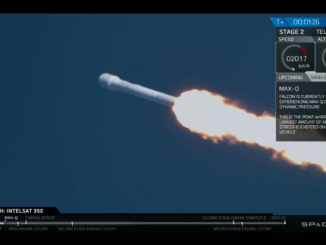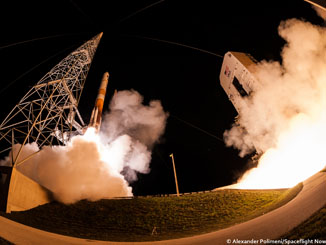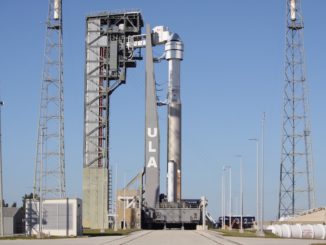Four unidentified Russian military satellites rode a modified Soyuz booster into orbit Wednesday from a remote space base north of Moscow.
The satellites lifted off at 1714 GMT (1:14 p.m. EDT) Wednesday from the Plesetsk Cosmodrome, a military launch base around 500 miles (800 kilometers) north of Moscow.
The launch occurred at 8:14 p.m. Moscow time.
A Soyuz 2-1v rocket and Volga upper stage carried the four satellites into orbit for the Russian Ministry of Defense, the Russian military said in a statement. The defense ministry said payloads launched Wednesday will study the effects of the environment of space on satellites, and assist in the calibration of military tracking radars.
The satellites were designated Kosmos 2535, 2536, 2537 and 2538 under the Russian Defense Ministry’s naming scheme for military spacecraft.
Russian officials did not publicize Wednesday’s launch in advance, apart from the release of standard pre-launch airspace warning notices. The warnings suggested the Soyuz 2-1v rocket was programmed to fly north from Plesetsk, heading on a flight path that would take the satellites over Earth’s poles on each orbit.
As of Thursday morning, independent tracking information from the U.S. military was not available for four new Russian military satellites.
Wednesday’s launch was the fifth flight of Russia’s light-class Soyuz 2-1v booster, which uses a single liquid-fueled NK-33 first stage engine originally developed for the Soviet-era N1 moon rocket. The Soyuz 2-1v replaces the Soyuz rocket’s four-nozzle core stage engine with a single-nozzle NK-33, and designers removed the four strap-on boosters that normally fly on Soyuz missions.
Four vernier steering engines are also mounted around the kerosene-fed NK-33 engine on the Soyuz 2-1v first stage. The modified launcher’s second stage is powered by an RD-0124 engine, the same type of powerplant also used on the modernized Soyuz 2-1b version of Russia’s classic Soyuz rocket.
Russian engineers kept the NK-33 engines in storage after the N1 moon rocket was canceled. Some of the NK-33 engines were exported to the United States, where they were upgraded to fly on Northrop Grumman’s Antares rocket to launch supplies to the International Space Station.
But an engine failure in 2014 prompted the Antares team to select a new powerplant for the rocket, and the Soyuz 2-1v is the only rocket currently flying with NK-33 engines.
The Soyuz 2-1v mission Wednesday was the second launch from the Plesetsk Cosmodrome this year, and the ninth flight of a Russian-built satellite launcher so far in 2019.
Email the author.
Follow Stephen Clark on Twitter: @StephenClark1.



